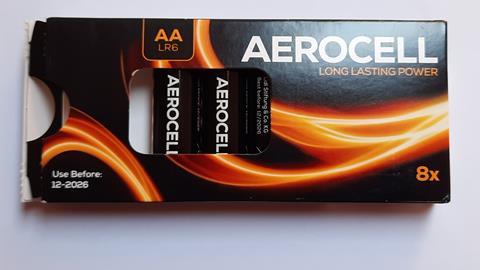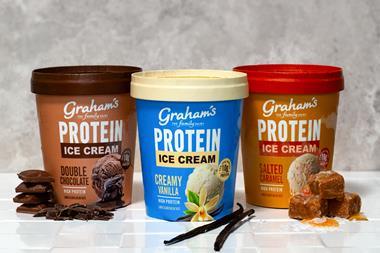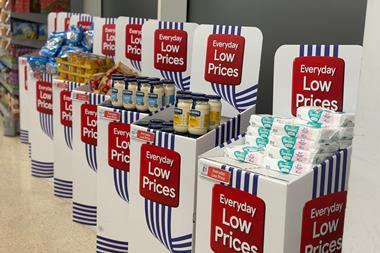It’s a discounter copycat legal battle but with a twist: this time a discounter claims it is the one being copied.
In a High Court dispute that emerged this week, Lidl has claimed Tesco’s Clubcard Prices logo, featuring a solid yellow circle on a blue background, is too similar to its own, and amounts to trademark infringement.
Lidl argues Tesco is trying to “ride on the coat-tails” of its discounter reputation. It says the yellow and blue design of its logo forms a “wordless” trademark, even without bearing its name.
As evidence, the discounter has presented findings from a survey in which “numerous” respondents identified a connection between the background alone and Lidl.
In response to which I would like to present exhibit A, the picture above, showing some batteries purchased this week in a Lidl supermarket. Look at the photo. Rack your brains. Can you think of anything it reminds you of? Anything at all?
Helpfully, Lidl hasn’t made it “wordless” but has written ‘Aerocell’ on it. Look at that, the choice of white block capitals, the word itself. Getting anything yet?
Of course, Lidl doesn’t only want to sell batteries that mimic the leading brand. It’s built its position as Britain’s sixth-biggest supermarket by applying this strategy far and wide.
It’s so widespread that, if you were visiting one of its branches for the first time, you might suspect you had accidentally stumbled into a parallel universe. Around the store, you will find this dimension full of things with which you are familiar, from the mayonnaise to shampoo… but then, on closer inspection, not quite.
This is the business model for both discounters: offer cheaper alternatives to big brands, while providing shoppers with the visual cues that suggest they are really not any different. By definition, that means using designs that might be identified as a having a connection with another business. Another way to describe it might be ‘riding on coat-tails’, and it’s a practice they have got away with for years.
Read more:
-
Lidl accuses Tesco of copying its logo to ‘ride on discounter coat-tails’
-
Aldi teases M&S again over the return of Cuthbert the Caterpillar
-
M&S to sell Choc on Choc matchsticks following copycat allegation
-
What we can learn from the Aldi and M&S battle over Colin and Cuthbert
“Discounters like Lidl are often seen as ‘sailing as close to the wind’ as they can in trademark terms when designing discounted products inspired by the leading brands,” says Kirsten Gilbert, partner at IP law firm Marks & Clerk. “There have been a number of high-profile disputes in this vein recently such as M&S and Aldi’s Colin the Caterpillar cake dispute.”
So, who would have guessed a discounter such as Lidl would be so defensive over some yellow and blue shapes?
“Tesco may feel there is an element of poacher turned gamekeeper here,” says John Coldham, IP partner at the international law firm Gowling WLG.
Lidl’s surprise aggression could be a sign of concern about Tesco’s discounted Clubcard prices, offered in return for loyalty to the supermarket. Lidl launched its legal claim last year, when its market share was not quite on the march again as it is now.
Coldham sees another potential motive: “I wonder whether Lidl is seeking to change perceptions so that the other grocers no longer feel they can take the moral high ground on lookalikes and sailing close to the brands of others.”
At an interim hearing on Monday, the High Court rejected an argument from Tesco that Lidl’s survey findings should be inadmissible, and the case is now set to proceed to trial next year.
A Tesco spokesman has said the decision has “no bearing on the merits” of Lidl’s claim, which “we deny and are strongly defending”. Lidl has declined to comment.
“Looking at the substance of this case, the claim that a yellow circle on a blue background is sufficiently distinctive of Lidl on its own is a robust position to take,” says Coldham.
“It will be an interesting case, but one where the most likely outcome is a confidential settlement.”
However, regardless of whether it remains confidential, the real winner will be plain to see. Lidl wants Tesco to stop using the blue and yellow background on its Clubcard Prices signs – so whether that continues in the wake of the case will speak volumes.

He’s responsible for covering the discounters and retail property, and for commissioning and editing The Grocer’s analysis features. He has over 20 years' experience as a journalist, during which his by line has appeared regularly in a range of national newspapers.
Follow Steve on Twitter: @Steve_Farrell_ View full Profile
























No comments yet